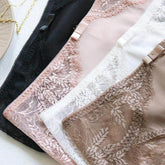Proper Care Guide: How to Wash and Maintain Silk Pajamas Without Damage
Preserving the exquisite quality of your silk sleepwear requires knowledge, precision, and care. This comprehensive guide reveals professional techniques to maintain the natural luster, softness, and durability of your silk pajamas, ensuring they remain a luxurious sleep companion for years to come.
Understanding Silk Pajamas
Silk is unique among textiles in its molecular structure and natural properties. Unlike cotton or synthetic fabrics, silk consists of protein fibers produced by silkworms, specifically the Bombyx mori moth when creating mulberry silk. These protein fibers contain 18 amino acids beneficial to human skin and include natural elements like albumen that create silk's distinctive characteristics.
The molecular structure of silk explains both its luxury and care requirements. Each silk strand comprises triangular prisms that refract light in multiple directions, creating the fabric's characteristic sheen and luminosity. This same structure, however, makes silk responsive to environmental factors including water temperature, pH levels, and mechanical stress.
Many consumers believe silk is too fragile for regular use, but this represents a fundamental misunderstanding. Silk is naturally robust despite its delicate appearance, with tensile strength comparable to steel wire of the same diameter. However, this strength doesn't eliminate the need for proper care. The protein-based structure of silk reacts differently to common cleaning methods than plant-based fabrics like cotton or synthetic petroleum-based materials.
When examining silk garments, quality variations become immediately apparent. Premium silk pajamas typically range between 19-22 momme weight (the standard measurement of silk density). This measurement, representing the weight in pounds of a piece of silk 45 inches by 100 yards, directly impacts the garment's durability, opacity, and care requirements. Higher momme weights generally indicate more substantial silk that may withstand slightly more rigorous cleaning techniques, while lighter weights demand gentler handling.
Understanding these fundamental characteristics provides essential context for the specific care instructions that follow. With proper maintenance, silk pajamas maintain their luxurious properties and can outlast many other fabric types in your wardrobe.

Preparing for Silk Pajama Care
Before undertaking any cleaning process, proper preparation ensures optimal results without risking damage to your valuable garments.
1. Decode the care label
Silk garment care labels contain standardized symbols that provide crucial information. The bucket symbol indicates washing methods, while lines beneath it specify agitation levels. Diagonal lines through symbols indicate prohibited actions. Most premium silk pajamas display the hand wash symbol (a hand in water) or the dry clean symbol (a circle). Manufacturers calibrate these recommendations based on the specific silk quality, dyes, and construction methods used.
2. Test for colorfastness
Before full immersion, verify color stability using this method:
- Dampen a white cotton swab or cloth with water and a small amount of your intended cleaning solution
- Gently rub an inconspicuous area of the garment for 30 seconds
- Examine the swab for color transfer
- Wait 15 minutes to ensure delayed color release isn't occurring
- If color appears on your testing material, consider professional cleaning instead
This testing proves particularly important for vibrant colors or patterns, which may require different handling than solid, neutral-colored silk items.
3. Gather appropriate supplies
For effective silk cleaning, assemble:
- pH-neutral detergent specifically formulated for silk (standard detergents typically measure 9-10 on the pH scale, while silk requires 4.5-6)
- White distilled vinegar for rinsing (restores silk's natural pH)
- Clean white towels (colored towels risk dye transfer)
- Large basin or clean sink (providing adequate space for gentle movement)
- Mesh laundry bags if machine washing becomes necessary
- Distilled water for areas with hard tap water (mineral deposits can dull silk)

"Assemble the proper supplies before beginning the silk cleaning process"
4. Identify prohibited products
Never expose silk to:
- Chlorine bleach (destroys protein fibers and yellows silk)
- Enzyme-based cleaners (digest protein stains but also damage silk proteins)
- Optical brighteners (coat fibers with synthetic residue that damages silk)
- Direct sunlight during cleaning or drying (UV rays break down protein structures)
- Sprays containing alcohol (dehydrate silk fibers causing brittleness)
These preparation steps establish the foundation for successful cleaning methods detailed in subsequent sections. Taking time for proper preparation significantly reduces the risk of irreversible damage during the cleaning process.
Hand Washing Silk Pajamas: The Preferred Method
Hand washing represents the gold standard for silk pajama care, providing precise control over every aspect of the cleaning process. This method minimizes mechanical stress on the fibers while allowing direct monitoring of the garment's response to cleaning.
The superiority of hand washing stems from its minimal agitation. Even delicate machine cycles create more friction than properly executed hand washing. This friction—not water itself—poses the greatest threat to silk's integrity. Additionally, hand washing allows immediate response to any unexpected color release or fiber behavior.
Begin with water temperature between 85°F and 95°F (29°C to 35°C). This specific range proves critical for proper cleaning. Temperatures below 85°F (29°C) prevent adequate dissolution of cleaning agents, while temperatures above 95°F (35°C) risk protein fiber damage similar to what occurs when cooking egg whites. Test the water with your inner wrist to ensure it feels comfortably tepid—never hot.
Select a cleanser formulated specifically for silk such as TENESTAR or Le Blanc Silk & Lingerie Wash. These products maintain the appropriate pH balance between 4.5-6.0 required for silk. In the absence of specialized products, baby shampoo serves as an acceptable alternative due to its gentle formulation and appropriate pH level. Add 1 teaspoon of cleanser per gallon (3.8 liters) of water, creating a subtle, not excessive, lather.
Fully submerge the garment and allow it to soak for precisely 3-5 minutes. This timing balances dirt dissolution with fiber protection. Extended soaking beyond 5 minutes risks weakening the protein structure, particularly at stress points like seams. During soaking, gently swirl the water occasionally without manipulating the garment directly.
Use gentle hand movements to clean the pajamas:
- Support the entire garment with both hands, keeping it beneath the water surface
- Press water through the fabric using flat palms rather than rubbing fabric against itself
- Give additional attention to collar, cuff, and underarm areas using light pressure from your fingertips—never your nails
- Maintain the garment's natural shape throughout the process
- Complete the entire cleaning process within 10 minutes to minimize fiber saturation
This method preserves the structural integrity of the silk while effectively removing body oils, perspiration residues, and environmental contaminants that compromise fabric performance and appearance.

Machine Washing Silk Pajamas: When Necessary
While hand washing remains optimal, certain circumstances may necessitate machine washing. These situations include time constraints, physical limitations that make hand washing difficult, or the need to clean multiple silk items simultaneously.
Critical protective measures must be implemented when using machine washing methods:
- Use a front-loading washing machine when available, as these create less mechanical stress than top-loading agitator models
- Select mesh laundry bags specifically designed for delicates, ensuring seams face inward to prevent snagging
- Choose bags with fine mesh (under 2mm openings) rather than standard mesh to minimize fabric movement
- Place only one pajama set per bag to prevent excessive friction
- Close all buttons and ties before placing items in bags
Machine settings require precise selection for silk safety:
- Choose "Delicate," "Hand Wash," or "Silk" cycle options (on common brands like Whirlpool, select "Handwash" or "Delicates"; on LG models, use "Delicate Hand Wash"; on Samsung, select "Delicates/Silk")
- Set water temperature to cold (below 85°F/29°C)
- Select the shortest cycle duration available (typically 15-30 minutes maximum)
- Disable any "extra rinse" functions that extend water exposure
- Reduce spin speed to lowest available setting (400-500 RPM maximum)
Color protection requires additional precautions when machine washing:
- Never mix colored silk with white or light-colored silk items
- Separate deep jewel tones (burgundy, navy, emerald) from brighter colors (red, royal blue)
- For pajamas with contrast piping or panels, turn inside-out to reduce friction on decorative elements
- Add 1/4 cup white vinegar to the rinse cycle to stabilize dyes and prevent bleeding
Machine washing inevitably creates more stress on silk fibers than hand washing. Reserve this method for situations where hand washing isn't feasible, limiting machine washing to no more than every third cleaning cycle for premium silk garments.

When machine washing is necessary, proper protection is essential
Proper Rinsing Techniques
Thorough rinsing represents a critical yet often overlooked aspect of silk care. Residual detergent compromises silk's natural properties, causing fiber stiffness, reduced breathability, and potential skin irritation for sensitive individuals.
Complete detergent removal requires methodical technique. Begin by draining the wash water and gently pressing—never wringing—excess water from the garment. Refill your basin with clean water at the same temperature as the wash water. Temperature consistency prevents shock to the fibers that can cause microscopic fractures in the protein structure.
Execute a three-stage rinsing process for optimal results:
- Initial rinse: Fully submerge the garment in fresh water, gently agitating to release captured detergent. Drain completely.
- Secondary rinse: Repeat with fresh water, gently pressing water through the fabric rather than disturbing the garment. Drain completely.
- Final vinegar rinse: Add precisely 1 tablespoon white distilled vinegar per quart (0.95 liters) of water. Soak the garment for 2 minutes, then drain without additional rinsing.
The vinegar rinse serves multiple critical functions. First, it neutralizes any alkaline detergent residues, restoring silk's natural pH balance. Second, it relaxes the protein fibers, enhancing the fabric's natural drape. Finally, it strengthens the hydrogen bonds between molecules, improving color vibrancy and surface luster. The minimal quantity used dissipates during drying, leaving no vinegar odor.
Handle wet silk with particular care during the rinsing process. Support the full weight of the wet garment at all times—wet silk can stretch up to 20% beyond its normal dimensions and may not return to its original shape if improperly handled. Never lift silk by the shoulder straps or delicate trim elements, as these areas experience maximum stress when wet.
The rinsing process directly impacts how your silk pajamas perform during the subsequent drying phase. Inadequate rinsing leaves surfactant molecules that attract and hold moisture, extending drying time and potentially causing water spotting. Conversely, properly rinsed silk dries more evenly and maintains better color consistency.
Drying Silk Pajamas Correctly
The drying process significantly impacts both the immediate appearance and long-term durability of silk pajamas. Proper techniques preserve the fabric's natural tension and prevent common issues like water spotting, fabric distortion, and color inconsistency.
Begin with gentle water extraction using the towel-rolling method:
- Lay the silk garment flat on a clean, white cotton towel
- Arrange the garment in its natural shape, aligning seams and smoothing pockets or panels
- Place a second clean towel on top of the garment
- Starting at one end, roll the towels and garment together into a cylindrical shape
- Apply even, moderate pressure to the roll—firm enough to transfer water but not so firm that you create new wrinkles
- Unroll and repeat with fresh towels if the initial towels become saturated
This method removes approximately 70% of moisture without applying direct pressure to any single area of the garment.
Select the appropriate drying approach based on the specific characteristics of your silk pajamas:
- Flat drying works best for heavier silk (19 momme and above) and structured garments with buttons, pockets, or collars
- Hanging may suit lighter silks (16-18 momme) and simple designs without heavy embellishments
- For sets, consider drying tops hanging and bottoms flat to maintain proper proportions
Create optimal environmental conditions for silk drying:
- Choose a location with moderate air circulation but away from direct airflow
- Maintain room temperature between 65°F-75°F (18°C-24°C)
- Ensure 40-60% humidity (very dry environments can cause static electricity issues)
- Position away from direct sunlight, which can fade colors and weaken fibers
- Allow 4-6 hours minimum drying time, preferably overnight
Never accelerate drying using heat sources, including hair dryers, heating vents, or radiators. Heat causes uneven drying that creates water spotting and can permanently alter the protein structure of silk fibers. Just as heat changes egg white from translucent to opaque, it transforms silk's molecular arrangement, reducing sheen and flexibility.
Patience during the drying process yields significant benefits in garment appearance and longevity. Properly dried silk maintains its natural luster, drape, and dimensional stability, providing the foundation for successful ironing or steaming in the next phase of care.

Ironing and Steaming Silk Pajamas
Restoring silk pajamas to their smooth, wrinkle-free state requires specific techniques that respect the fabric's protein structure. With proper approach, silk responds beautifully to gentle heat application while maintaining its natural characteristics.
Iron settings must be matched precisely to silk weight:
- Lightweight silk (12-16 momme): "Silk" setting or Low (240°F/115°C maximum)
- Medium silk (17-19 momme): Between "Silk" and "Wool" settings (265°F/130°C maximum)
- Heavy silk (20-30 momme): "Wool" setting (275°F/135°C maximum)
Modern iron manufacturers calibrate these standardized settings based on fiber heat tolerance. When in doubt, begin with the lowest temperature and increase gradually if needed.
Execute proper ironing technique:
- Ensure the silk is still slightly damp (approximately 95% dry)
- Turn the garment inside out to protect the outer surface
- Place a pressing cloth between the iron and silk (100% cotton muslin works best)
- Iron in straight, continuous movements rather than circular motions
- Maintain constant movement, never allowing the iron to rest in one position
- Work from larger panels toward details like cuffs or collars
- Allow the garment to rest on a flat surface for 30 minutes after ironing to set the fibers
For delicate or embellished areas, use the "hovering" technique:
- Hold the iron 1/2 inch above the fabric surface
- Allow steam to penetrate the fibers without direct contact
- Smooth the fabric gently with your free hand after steam application
Steaming offers an excellent alternative for maintaining silk pajamas between washings or for addressing minor wrinkles. Use a handheld garment steamer with these guidelines:
- Hold the steamer head 6-8 inches from the fabric
- Steam in downward strokes, following the fabric grain
- Allow 2-3 seconds of steam contact before moving to the next section
- Complete the entire garment within 5 minutes to prevent excessive moisture absorption
Both ironing and steaming create a moisture-heat combination that temporarily relaxes the hydrogen bonds within silk fibers. As the fabric cools and dries, these bonds reform in the desired smooth arrangement. This process works with silk's natural properties rather than forcing the fabric into an unnatural state.
After heat treatment, allow pajamas to cool completely on a flat surface before hanging or storing. This cooling period allows the protein structure to stabilize in its new configuration, prolonging the wrinkle-free results.

Storing Silk Pajamas Properly
Proper storage protects silk pajamas from environmental factors that can compromise their quality between wearings. Implementing optimal storage conditions extends garment life while maintaining the fabric's luxurious properties.
Environmental conditions significantly impact silk during storage:
- Maintain humidity between 40-50% (too dry causes brittleness; too humid promotes mildew)
- Keep temperature stable between 60-75°F (16-24°C)
- Shield from direct light, particularly sunlight and fluorescent sources, which degrade protein fibers
- Ensure good air circulation to prevent moisture accumulation
Choose between folding and hanging based on garment characteristics:
- Fold heavyweight silk (19+ momme) to prevent stretching
- Hang lightweight silk items on padded hangers to prevent creases
- For pajama sets, fold bottoms and hang tops when possible
- Always use hanging loops if provided by the manufacturer
Implement protective measures against common storage threats:
- Place acid-free tissue paper between folds to prevent sharp creases
- Use cotton garment bags rather than plastic, which traps humidity
- Position cedar blocks nearby rather than in direct contact with silk
- Store with lavender sachets rather than mothballs (naphthalene damages protein fibers)
- Keep colored silk separate from white silk during long-term storage
Adjust storage methods seasonally for optimal protection:
- Summer storage: Increase air circulation and check for humidity-related issues weekly
- Winter storage: Monitor for excessive dryness, particularly in heated environments
- Seasonal transition: Allow garments to "breathe" outside storage for 24 hours before wearing
When storing silk pajamas long-term (beyond one season), take additional precautions:
- Clean thoroughly before storage, as invisible body oils attract insects
- Wrap in unbleached muslin rather than plastic
- Place in a breathable container on a center shelf rather than floor or ceiling areas
- Refold items in different patterns every three months to prevent permanent crease lines
- Inspect periodically for moisture, pests, or pressure marks
Proper storage forms the critical bridge between cleaning cycles, preserving the benefits of your careful washing and finishing efforts. The time invested in correct storage significantly reduces the need for interventive care and maintains the luxury experience of your silk sleepwear.
Dealing with Stains on Silk Pajamas
Stain management requires swift, strategic action to prevent permanent damage to silk pajamas. Different substances demand specific approaches, with timing and technique significantly influencing outcomes.
Immediate response proves crucial for all stain types:
- Blot—never rub—excess material with white, lint-free cloth
- Apply appropriate treatment within 15-30 minutes when possible
- Work from stain perimeter toward center to prevent spreading
- Test all treatments on an inconspicuous area before applying to the stain
Specific treatment protocols by stain category:
For oil-based stains (makeup, skincare products, food oils):
- Apply cornstarch or talcum powder directly to the stain
- Allow to sit undisturbed for 4-6 hours to absorb oils
- Brush away powder with soft brush
- Spot clean any residue with diluted silk detergent on a cotton swab
For protein-based stains (perspiration, body fluids):
- Dilute white vinegar (1 part vinegar to 2 parts cold water)
- Apply to stain with cotton swab using light dabbing motions
- Allow to work for 5 minutes maximum
- Rinse thoroughly with cool water
For tannin stains (coffee, tea, wine):
- Create solution of 1 teaspoon glycerin, 1 teaspoon dish soap, 8 ounces cold water
- Apply with eye dropper or cotton swab
- Wait 3-5 minutes
- Rinse with cool water
For beverage and food stains:
- Quickly rinse from back side of fabric with cold running water
- Create paste of baking soda and water (consistency of toothpaste)
- Apply to stain with soft toothbrush using circular motions
- Allow to dry completely, then brush away residue
Implement advanced spot cleaning techniques for stubborn stains:
- Place white absorbent cloth beneath stained area
- Apply appropriate solution with cotton swab
- Work in one-inch circular pattern from outside toward center
- Blot with clean section of cloth frequently
- Repeat until transfer to absorbent cloth diminishes or stops
- Rinse treated area thoroughly
Professional cleaning becomes necessary when:
- The stain persists after two home treatment attempts
- The stain has penetrated deeply into the fabric
- The affected area exceeds one inch in diameter
- The stain involves ink, paint, adhesives, or unknown substances
- The garment shows color changes around the stained area during treatment
Stain management success rates decrease dramatically after 24 hours, when substances bond more permanently with silk fibers. Prioritize swift action while avoiding harsh chemicals that damage the protein structure of silk more severely than the stain itself.
Long-Term Maintenance Schedule
Establishing a regular maintenance routine preserves silk pajamas' quality over time. A structured approach prevents cumulative damage while addressing seasonal challenges and use patterns.
Adjust washing frequency according to specific factors:
- Standard wear (3-4 nights weekly): Wash every 3-4 wearings
- Light wear (1-2 nights weekly): Wash every 5-6 wearings
- Summer months or warm sleepers: Increase frequency by 30%
- Winter months or cool environments: May extend between washings by 20%
- After exposure to perfumes or skincare products: Wash immediately regardless of schedule
Implement monthly care practices:
- Inspect seams and stress points for early signs of wear
- Check button attachment and reinforcement stitching
- Assess overall color consistency and address any uneven areas
- Verify storage conditions remain optimal
- Refold items along different lines to prevent permanent creases
Quarterly maintenance enhances longevity:
- Perform thorough assessment in natural daylight
- Inspect for UV exposure effects if stored near windows
- Address any developing yellow tones with specialized treatments
- Evaluate elastic components in waistbands for resilience
- Consider professional cleaning for deep refreshment
Seasonal transitions require specific attention:
- Spring preparation: Address winter storage compression and static issues
- Summer preparation: Implement more frequent washing schedule
- Fall preparation: Check for sun exposure damage from summer months
- Winter preparation: Adjust for heating system effects on fabric moisture
Annual assessment determines intervention needs:
- Compare current condition to original appearance
- Evaluate overall fabric sheen and drape
- Test fabric strength at stress points
- Assess elastic component functionality
- Consider professional conditioning treatments for aged silk
This structured maintenance approach transforms silk pajama care from reactive to proactive, preventing many common issues before they develop. Regular attention allows early intervention for minor concerns before they require more intensive treatment, preserving both the aesthetic and functional qualities of your investment.
Special Care for Embellished Silk Pajamas
Decorated silk pajamas present unique care challenges, requiring techniques that protect both the base fabric and embellishments. Different decoration types demand specialized approaches to preserve their distinctive characteristics.
Lace-trimmed silk requires particular attention:
- Identify lace composition (cotton, nylon, or silk) to determine compatible care methods
- Hand wash exclusively, never machine wash regardless of base fabric recommendations
- Use finger-pressing rather than conventional ironing on lace elements
- Allow lace sections to air dry completely before applying any heat to nearby silk
- Store with tissue supporting lace edges to prevent permanent folds or creases
Embroidered silk demands protective measures:
- Wash inside-out to minimize friction on raised threads
- Place mesh over embroidered sections during washing to prevent thread catching
- Dry flat with embroidered side up to maintain dimensional stability
- Steam rather than iron decorated areas when possible
- For pressing, use a thick terry cloth towel beneath embroidery to prevent flattening
Beaded or sequined embellishments require specialized handling:
- Test attachment security before each washing by gently tugging random elements
- Hand wash exclusively using minimal agitation
- Never wring or twist, even gently
- Reshape and dry flat on absorbent towel
- Avoid hangers for beaded garments, as weight distribution causes distortion
- Store flat with acid-free tissue between layers
Printed silk patterns benefit from specific techniques:
- Wash in cold water exclusively to prevent dye migration
- Add 1/4 cup white vinegar to final rinse to set pattern colors
- Dry in shade to prevent pattern fading
- Iron from reverse side only, never directly on printed surface
- For digital prints, avoid contact with alcohol-based products including perfumes
Appliquéd elements present unique challenges:
- Identify both appliqué and base fabric compositions
- Follow care requirements for the more delicate component
- Provide support beneath appliqué during washing to prevent stress on attachment points
- Use finger pressing and steam rather than direct iron contact
- Consider spot cleaning for the main fabric when possible to avoid fully immersing appliqués
With decorated silk pajamas, preventive care significantly reduces the need for interventive treatments that might compromise either the embellishments or the base fabric. When properly maintained, these special details often outlast expected garment lifespans, preserving both the aesthetic and monetary value of premium silk sleepwear.
Troubleshooting Common Silk Pajama Issues
Even with diligent care, silk pajamas may develop specific conditions requiring correction. Understanding these common issues and their remedies allows for effective intervention without compromising fabric integrity.
Yellowing Silk Restoration
Problem: Protein fibers naturally yellow with age, exposure to body oils, or improper storage.
Solution:
- Create solution of 1 quart cool water with 1/4 cup hydrogen peroxide (3% concentration)
- Soak affected garment for exactly 20 minutes
- Rinse thoroughly with cool water
- Add 1 tablespoon white vinegar to final rinse
- Dry normally, away from sunlight
For stubborn yellowing, professional cleaning remains the safest option. Avoid chlorine bleach under all circumstances, as it irreversibly damages silk proteins.
Water Spot Removal
Problem: Uneven drying creates ring-shaped water marks with different light reflection.
Solution:
- Dampen entire garment evenly to matching saturation level
- Gently roll in towel to remove excess moisture
- Hang to dry in steamy bathroom environment
- Iron while still slightly damp with pressing cloth
- If spots persist, professional wet cleaning may be necessary
Preventing water spots through proper initial drying represents the most effective approach, as correction may require multiple attempts.
Restoring Silk Luster
Problem: Residue buildup or fiber damage causes dull appearance and reduced sheen.
Solution:
- Mix 2 cups cool water with 1 tablespoon white distilled vinegar
- Rinse clean silk thoroughly in solution
- Do not rinse out the vinegar solution
- Roll gently in towel and dry flat
- Iron at appropriate temperature while still slightly damp
For severe dullness, professionals may employ silicone-free finishing agents specifically formulated for protein fibers.
Addressing Snags and Pulls
Problem: Silk's smooth surface catches on rough surfaces, causing thread displacement.
Solution:
- Never cut a pulled thread, which creates weakness in the fabric structure
- For minor snags, use a fine crochet hook (0.6mm) inserted from the wrong side
- Gently draw the thread to the reverse side
- Distribute tension by stroking the area with fingertip
- For larger snags, seek professional repair to prevent hole development
Preventive measures include inspecting hands for rough cuticles and removing jewelry before handling silk garments.
Shrinkage Correction
Problem: Excessive heat or agitation causes silk fiber contraction.
Solution:
- Soak garment in lukewarm water with hair conditioner (1 tablespoon per gallon)
- Gently stretch to original dimensions while damp
- Pin to shape on flat surface covered with clean towel
- Allow to dry naturally, reshaping periodically
- Limit stretching to 3-5% beyond current size per treatment to prevent fiber stress
Severe shrinkage may require multiple gentle treatments rather than one aggressive stretching session. Professional steam blocking provides the safest approach for valuable items.
Addressing these common issues promptly prevents them from becoming permanent conditions. With proper intervention, most silk pajama problems can be resolved while maintaining fabric integrity and extending useful garment life.
Eco-Friendly Silk Pajama Care
Sustainable silk pajama maintenance aligns environmental responsibility with optimal fabric care. Natural methods often prove gentler on delicate fibers while reducing ecological impact through reduced chemical usage and resource conservation.
Select environmentally conscious detergents with these characteristics:
- Plant-derived surfactants rather than petroleum-based
- Biodegradable formulations that break down completely
- Free from synthetic fragrances, optical brighteners, and phosphates
- Concentrated formulas requiring minimal packaging
- pH-balanced specifically for protein fibers
Look for ingredients like saponified coconut oil, sodium cocoate, and vegetable glycerin rather than linear alkylbenzene sulfonates (LAS) or sodium laureth sulfate. Products like Eucalan, Soak, and Ecover deliver effective cleaning without harsh environmental impacts.
Implement water conservation techniques during the cleaning process:
- Pre-treat spots to reduce full-immersion washing frequency
- Collect rinse water for household plants (final vinegar rinse benefits acid-loving plants)
- Wash multiple silk items together when colors permit
- Use basin rather than running water for washing and rinsing
- Time soaking and rinsing phases precisely to avoid excessive water use
Replace conventional products with natural alternatives:
- Use lemon juice (1 tablespoon per gallon of water) rather than commercial fabric brighteners
- Apply diluted vodka spray (1:3 ratio with water) for odor elimination between washings
- Substitute white vinegar for commercial fabric softeners
- Employ baking soda paste for spot treatment rather than chemical stain removers
- Use steam refreshing rather than full washing when appropriate
Extend time between washings through preventive measures:
- Air pajamas for 30 minutes after wearing before storing
- Use undergarments beneath pajamas during sleep to reduce direct skin contact
- Avoid applying body products immediately before wearing silk sleepwear
- Rotate between multiple pajama sets to extend time between cleanings
- Implement steam refreshing between full washing cycles
Consider end-of-life fabric disposition when garments become unwearable:
- Natural silk biodegrades completely within 1-5 years in composting conditions
- Remove non-biodegradable elements like plastic buttons before composting
- Consider repurposing into smaller items like eye masks or sachets
- Donate to textile recycling programs specializing in natural fibers
- Research local fabric recycling options for proper disposition
These sustainable approaches often enhance silk longevity while reducing environmental impact. Many traditional silk care techniques evolved before the introduction of harsh chemicals, working with the fabric's natural properties rather than against them. By returning to these methods, you achieve both superior garment care and environmental responsibility.
Understanding Different Types of Silk
Not all silk is created equal. Various types offer different characteristics that directly impact care requirements, durability, and performance. Understanding these differences helps you select the appropriate maintenance approach for your specific silk pajamas.
Mulberry silk represents the gold standard in the industry, accounting for over 90% of global silk production. Produced by Bombyx mori silkworms fed exclusively on mulberry leaves, this silk type features extraordinarily uniform filaments with consistent diameter and minimal irregularities. Mulberry silk contains 18 amino acids beneficial to human skin and naturally maintains 11% moisture content, creating its characteristic temperature-regulating properties. This silk type typically requires the gentlest care due to its fine, regular fibers, but rewards with superior durability when properly maintained.
Tussah silk (wild silk) offers a distinct alternative with unique properties. Produced by wild silkworms feeding on oak and juniper leaves, these fibers exhibit natural color variations ranging from light tan to deep brown. Tussah features thicker, shorter filaments with a slightly textured hand. This structure creates greater durability against mechanical stress but less natural sheen than mulberry varieties. Tussah silk generally tolerates slightly higher washing temperatures (up to 85°F/30°C) and may withstand mild agitation better than mulberry silk, though color preservation requires equal care.
Eri silk provides exceptional thermal properties due to its hollow fiber structure. Sometimes called "peace silk" because its production allows the silkworm to emerge before harvesting the cocoon, eri features a matte appearance and wool-like texture. The discontinuous fiber structure creates a naturally stretchier fabric that accommodates gentle machine washing better than other silk types, though color fastness remains a concern. Its hollow fibers make it exceptionally warm, making it more common in winter-weight pajamas.
The quality indicators of silk extend beyond type to include:
| Quality Factor | Premium Characteristics | Budget Characteristics |
|---|---|---|
| Momme Weight | 19-22 momme for sleepwear | 12-16 momme |
| Weave Structure | 4-way stretch charmeuse or sophisticated jacquard | Basic charmeuse or habotai |
| Thread Count | 600+ threads per inch | 400-500 threads per inch |
| Fiber Length | Long-strand silk with minimal joining | Short fibers with more jointing points |
These quality factors directly influence appropriate care methods. Higher momme weights, sophisticated weaves, and long-fiber construction generally indicate silk that better withstands proper cleaning processes while maintaining its luxurious characteristics. However, even premium silk requires appropriate care to preserve its investment value.
The care label often indicates silk type and quality through specific language. Terms like "100% Mulberry Silk" or "Grade 6A Silk" indicate premium fibers requiring careful maintenance, while "Silk Blend" or unspecified "100% Silk" may indicate varieties that tolerate slightly more robust cleaning. When in doubt, default to the gentlest care methods to preserve your garment's integrity.
Preserving the Luxury of Silk Pajamas
The relationship between proper care and garment longevity remains inseparable when discussing silk pajamas. By implementing the comprehensive methods outlined in this guide, you transform routine maintenance into an investment protection strategy that preserves both the tangible and intangible elements of luxury silk sleepwear.
Physical maintenance preserves measurable fabric characteristics including tensile strength, color stability, and structural integrity. Properly maintained silk pajamas retain their original dimensions and details even after years of regular use. Scientific testing confirms that silk cleaned according to appropriate protein fiber protocols maintains up to 90% of its original strength, while improper cleaning can reduce strength by 30-40% after just ten washing cycles. This preservation extends beyond aesthetics to genuine functional longevity.
Sensory experiences define the luxury of silk sleepwear beyond simple durability. The characteristic smooth hand, subtle luster, and fluid drape create the distinctive experience that separates premium silk from ordinary fabrics. These qualities emerge from silk's unique molecular structure—a structure preserved through appropriate care techniques. When you follow proper maintenance protocols, you protect not just the material object but the complete sensory experience that motivated your initial investment.
Environmental factors play crucial roles in extending silk pajama lifespans beyond expected norms. By controlling exposure to harsh detergents, excessive agitation, and improper temperature, you prevent cumulative damage that shortens garment life. Similarly, appropriate storage protects against environmental degradation between wearings. These protective measures allow silk pajamas to serve not just as temporary luxuries but as enduring components of your personal comfort system.
Economic value remains inextricably linked to condition. Premium silk pajamas represent significant investments that, unlike many consumer goods, can maintain their performance characteristics for decades when properly maintained. The methods outlined in this guide require minimal financial investment while preserving substantial garment value. This value retention extends beyond monetary worth to include the reduced environmental impact of longer-lasting garments that minimize resource consumption through extended usefulness.
The time invested in understanding and implementing proper silk care yields exponential returns in both garment longevity and maintained luxury experience. By working with silk's natural properties rather than against them, you establish a maintenance relationship that preserves your investment while continuing to deliver the extraordinary comfort and aesthetic pleasure that only properly maintained silk can provide.
The journey from understanding silk's unique characteristics through implementation of appropriate care techniques culminates in this essential truth: with proper care, silk pajamas transcend their role as simple garments to become enduring luxury experiences that improve with understanding and attention. The methods detailed throughout this guide provide the foundation for this transformation from ordinary ownership to enlightened stewardship of an exceptional natural material.
Frequently Asked Questions About Silk Pajama Care
The nuanced nature of silk care often generates specific questions. These comprehensive answers address common concerns while providing deeper insight into silk's unique properties.
Does silk truly require such specialized care, or is this mainly marketing hype?
Silk's unique care requirements stem from its biochemical structure rather than marketing claims. Unlike cellulose-based plant fibers (cotton, linen) or petroleum-derived synthetics, silk consists of protein fibers similar to human hair. This protein structure responds differently to pH levels, water temperature, and mechanical stress than other textiles. Electron microscopy confirms that silk's characteristic triangular prism fibers lose their light-refractive properties when exposed to improper cleaning methods, resulting in measurable luster reduction and strength compromise. The care methods outlined protect this distinct molecular structure.
How does momme weight affect silk pajama care requirements?
Momme weight directly impacts care procedures through fiber density and construction stability. Higher momme weights (19-22) contain more silk protein per square inch, creating greater tensile strength and resilience during cleaning. These heavier silks generally withstand slightly more mechanical action and moderate temperature fluctuations. Lighter weights (12-16 momme) require gentler handling due to reduced fiber density. Additionally, higher momme fabrics typically exhibit better colorfastness and dimensional stability during washing due to the manufacturing processes used for premium silk. Always verify the specific momme weight of your garments before establishing a care routine.
Can I safely wash silk pajamas with other delicate items to save water and time?
Combining silk with specific other delicates requires careful consideration of several factors. Silk may safely combine with other protein-based fibers like wool or cashmere when all items are colorfast and similar in weight. However, never wash silk with synthetic delicates containing static-generating fibers, which attract and hold dirt particles. Similarly, avoid cotton blends that produce lint that adheres to silk's microscopically rough surface. If washing multiple items, never exceed 1/3 of your basin or machine capacity, and increase the detergent-to-water ratio by 15% to account for potential cross-fiber contamination. When in doubt, wash silk items separately to preserve their distinct qualities.
Why do professional cleaners sometimes refuse to clean silk pajamas or charge premium prices?
Professional cleaning establishments distinguish between dry cleaning and wet cleaning processes, each requiring different equipment, solvents, and expertise. Many standard dry cleaners use petroleum-based solvents that can damage silk's protein structure or strip its natural sericin content. Specialized cleaners offering "wet cleaning" techniques utilize temperature-controlled water, neutral pH detergents, and controlled agitation specifically calibrated for protein fibers. This specialized knowledge and equipment justifies premium pricing, particularly for embellished or high-value silk garments. When seeking professional cleaning, specifically request a cleaner experienced with natural silk rather than assuming all "delicate" cleaning processes are suitable.





















